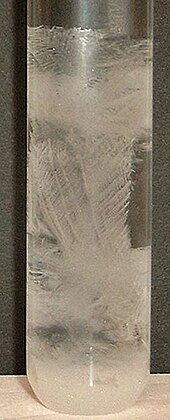Storm glass

A storm glass is a type of weather forecasting device, composed of a sealed glass container filled with liquid. The appearance of the liquid purportedly predicts the weather, but modern experiments have failed to confirm this.
Description
The liquid within the glass is a mixture of several ingredients, most commonly distilled water, ethanol, potassium nitrate, ammonium chloride, and camphor. This specific mixture was developed by Admiral Robert FitzRoy and used on his voyage with Charles Darwin on HMS Beagle.[1]
During the historic voyage, FitzRoy carefully documented how the storm glass would predict the weather:[2]
- If the liquid in the glass is clear, the weather will be bright and clear.
- If the liquid is cloudy, the weather will be cloudy as well, perhaps with precipitation.
- If there are small dots in the liquid, humid or foggy weather can be expected.
- A cloudy glass with small stars indicates thunderstorms.
- If the liquid contains small stars on sunny winter days, then snow is coming.
- If there are large flakes throughout the liquid, it will be overcast in temperate seasons or snowy in the winter.
- If there are crystals at the bottom, this indicates frost.
- If there are threads near the top, it will be windy.
In 1859, violent storms struck the British Isles. In response, the British Crown distributed storm glasses, then known as "FitzRoy's storm barometers," to many small fishing communities around the British Isles that were to be consulted by ships at port before setting sail.

Accuracy
An article in the Journal of Crystal Growth, whose conclusion was that temperature change is the sole cause of crystal growth in storm glasses.[3]
Cecil Adams performed informal experiments with a storm glass and found that the success of prediction was no better than random probability.[4]
Ingredients
- 2.5 g potassium nitrate
- 2.5 g ammonium chloride
- 33 ml distilled water
- 40 ml ethanol
- 10 g camphor
Warm the water and dissolve the potassium nitrate and ammonium chloride; add the ethanol; add the camphor. Place in corked test tube.
See also
- Tempest Prognosticator – an alternative to the storm glass that the British government investigated
References
- ^ Storm Glass, Mount Washington Observatory
- ^ FitzRoy's Storm Glass, About.com
- ^ Tanaka, Yasuko et al. "Pattern formation of crystals in storm glass" Journal of Crystal Growth 310 (2008): 2668–2672.
- ^ Can storm glasses predict the weather? from The Straight Dope
